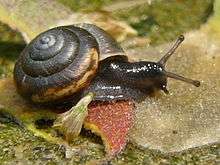Trochulus
| Trochulus | |
|---|---|
 | |
| An older adult individual of Trochulus hispidus with most of the hairs worn off of the shell | |
| | |
| Five views of a shell of Trochulus hispidus | |
| Scientific classification | |
| Kingdom: | Animalia |
| Phylum: | Mollusca |
| Class: | Gastropoda |
| (unranked): | clade Heterobranchia clade Euthyneura clade Panpulmonata clade Eupulmonata clade Stylommatophora informal group Sigmurethra |
| Superfamily: | Helicoidea |
| Family: | Hygromiidae |
| Subfamily: | Hygromiinae |
| Tribe: | Trochulini |
| Genus: | Trochulus Chemnitz, 1786[1] |
| Synonyms | |
|
Trichia Hartmann, 1840[2] | |
Trochulus is a genus of small air-breathing land snails, terrestrial pulmonate gastropod mollusks in the family Hygromiidae, the hairy snails and their allies.
Taxonomy
Trichia Hartmann, 1840[2] is a junior synonym of Trochulus Chemnitz, 1786.[3]
Nearly every malacological work prior to 2006 used the name Trichia instead of the (now considered valid) name Trochulus.
Species

The speciation centre for the genus Trochulus is in the Alps.[4]
The type species of this genus is Trochulus hispidus.
Species within the genus Trochulus include:[5][6]
Subgenus Trochulus Chemnitz, 1786
- Trochulus alpicola (Eder, 1921)
- Trochulus ataxiacus (Fagot, 1884)
- Trochulus biconicus (Eder, 1917) - synonym: Trichia biconica
- Trochulus glyptus (Locard, 1880) - synonym: Trochulus caelatus (Studer, 1820) - synonym: Trichia caelata[7]
- Trochulus clandestinus (Hartmann, 1821)
- Trochulus coelomphala (Locard, 1888)
- Trochulus erjaveci (Brusina, 1870)
- Trochulus graminicola (Falkner, 1973) - synonym: Trichia gramnicola
- Trochulus hispidus (Linnaeus, 1758) - synonym: Trichia hispida (Linnaeus, 1758)
- Trochulus montanus (Studer, 1820)
- Trochulus oreinos (Wagner, 1915) - synonym: Trichia oreinos
- Trochulus phorochaetius (Bourguignat, 1864)
- Trochulus plebeius (Draparnaud, 1805) - synonym: Trichia plebeia
- Trochulus sericeus (Draparnaud, 1801) - synonym: Trichia sericea (Draparnaud, 1801)
- Trochulus striolatus (C. Pfeiffer, 1828) - synonym: Trichia striolata
- Trochulus suberectus (Clessin, 1878)
- Trochulus villosus (Draparnaud, 1805)
- Trochulus villosulus - (Rossmässler, 1838) - synonym: Trichia villosula (Rossmässler, 1838)
- Trochulus waldemari (Wagner, 1912)
Subgenus Plicuteria Schileyko, 1978[8]
- Trochulus lubomirskii (Ślósarski, 1881) - synonym: Trichia lubomirskii
Based on molecular analyses, Trochulus lubomirskii does not belong to the genus Trochulus.[9]
Hair on shells
The periostracum of the shells of most Trochulus species has hair-like features. Some of the hair-less species do possess hairs as juveniles. Hairy shells appeared to be the ancestral character state in the genus Trochulus, a feature which has most probably been lost three times independently.
These losses were correlated with a shift from humid to dry habitats, indicating an adaptive function of hairs in moist environments. It had been previously hypothesised that these costly protein structures of the outer shell layer facilitate locomotion in moist habitats. Experiments by Pfenninger et al. (2005)[9] showed an increased adherence of haired shells to wet surfaces. The possession of hairs facilitates the adherence of the snails to their herbaceous food plants during foraging, when humidity levels are high. The absence of hairs in some Trochulus species could thus be explained as a loss of the potential adaptive function linked to habitat shifts.[9]
Feeding habits
Trochulus species in moist habitats prefer to forage on large-leaved herbaceous plants like Adenostyles, Urtica (nettles), Homogyne or Tussilago (coltsfoot etc).[9]
References
This article incorporates CC-BY-2.0 text from reference.[9]
- ↑ (German) Chemnitz J. H. (1786) Neues systematisches Conchylien-Cabinet. Neunten Bandes zwote Abtheilung, enthaltend die ausführliche Beschreibung von den Land- und Flußschnecken, oder von solchen Conchylien, welche nicht im Meere, sondern auf der Erde und in süssen Wassern zu leben pflegen. Mit zwanzig nach der Natur gemalten und durch lebendige Farben erleuchteten Kupfertafeln. pp. I-XXVI [= 1-26], 1-194, Tab. 117-136. Nürnberg. (Raspe).
- 1 2 (German) Hartmann J. D. W. (1844) Erd- und Süsswasser-Gasteropoden der Schweiz. Mit Zugabe einiger merkwürdigen exotischen Arten. I. Band. pp. i-xx [= 1-20], 1-227, Tab. I-XII [= 1-12], I-XII [sic, = 13-24], 25-84. St. Gallen. (Scheitlin & Zollikofer).
- ↑ (30 September 2004) ICZN Opinion 2079. Bulletin of Zoological Nomenclature 61(3).
- ↑ (Czech) Hrabáková M., Juřičková L. & Petrusek A. (2006) "Problematika rodu Trochulus (Mollusca, Gastropoda) v České republice". In: Bryja J. & Zukal J. (eds.) 2006. Zoologické dny Brno 2006. Sborník abstraktů z konference 9.-10. února. ISBN 80-903329-4-3, 268 pp., pages 42-43.
- ↑ Species in genus Trochulus. AnimalBase. Accessed 29 December 2008.
- ↑ Trichia. Fauna Europaea, accessed 2 December 2009.
- ↑ Trichia (Trichia) glypta. Molluscs of central Europe, accessed 2 December 2009.
- ↑ Schileyko A. A. (February 1978) "On the systematics of Trichia s. lat. (Pulmonata: Helicoidea: Hygromiidae)". Malacologia 17(1): 1-56.
- 1 2 3 4 5 Pfenninger M., Hrabáková M., Steinke D. & Dèpraz A. (4 November 2005) "Why do snails have hairs? A Bayesian inference of character evolution". BMC Evolutionary Biology 5: 59. doi:10.1186/1471-2148-5-59
Further reading
- Depraz A., Rathey E. & Hausser J. (7 December 2007) "Characterization of 13 polymorphic microsatellite loci for two land snail species, Trochulus villosus and T. sericeus (Gastropoda: Pulmonata: Hygromiidae)". Molecular Ecology Notes. doi:10.1111/j.1471-8286.2007.02055.x
- Hrabáková M., Juřičková L. & Petrušek A. (2006) "Taxonomy of the genus Trochulus (Gastropoda: Hygromiidae) in the Czech Republic".
- Kruckenhauser, L., Duda, M., Bartel, D., Sattmann, H., Harl, J., Kirchner, S. & Haring, E. (2014) "Paraphyly and budding speciation in the hairy snail (Pulmonata, Hygromiidae). — Zoologica Scripta, 00, 000–000."